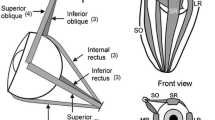Abstract.
Rotations of the eye are generated by the torques that the eye muscles apply to the eye. The relationship between eye orientation and the direction of the torques generated by the extraocular muscles is therefore central to any understanding of the control of three-dimensional eye movements of any type. We review the geometrical properties that dictate the relationship between muscle pulling direction and 3D eye orientation. We then show how this relation can be used to test the validity of oculomotor control hypotheses. We test the common modeling assumption that the extraocular muscle pairs can be treated as single bidirectional muscles. Finally, we investigate the consequences of assuming fixed muscle pulley locations when modeling the control of eye movements.
Similar content being viewed by others
References
Demer JL, Miller JM, Poukens V, Vinters HV, Glasgow BJ (1995) Evidence for fibromuscular pulleys of the recti extraocular muscles. Invest Ophthalmol Vis Sci 36:1135–1136
Demer JL, Oh SY, Poukens V (2000) Evidence for active control of rectus extraocular muscle pulleys. Invest Ophthalmol Vis Sci 41:1280–1290
Demer JL, Kono R, Wright W (2003a) Magnetic resonance imaging of human extraocular muscles in convergence. J Neurophysiol 89:2072–85
Demer JL, Oh SY, Clark RA, Poukens V (2003b) Evidence for a pulley of the inferior oblique muscle. Invest Ophthalmol Vis Sci 44:3856–3865
Haustein W (1989) Considerations on listing’s law and the primary position by means of a matrix description of eye position control. Biol Cybern 60:411–420
Hepp K (1994) Oculomotor control: listing’s law and all that. Curr Opin Neurobiol 4:862–868
Koene AR (2002) Eye mechanics and their implications for eye movement control. Utrecht University, Utrecht, The Netherlands ISBN 90-393-3185-5
Miller JM, Robinson DA (1984) A model of the mechanics of binocular alignment. Comput Biomed Res 17:436–470
Miller JM, Demer JL, Rosenbaum AL (1993) Effect of transposition surgery on rectus muscle paths by magnetic resonance imaging. Ophthalmology 100:475–487
Miller JM, Pavlovski DS, Shamaeva I (1999) Orbit tm 1.8 Gaze mechanics simulation, Eidactics, San Francisco
Misslisch H, Tweed D (2001) Neural and mechanical factors in eye control. J Neurophysiol 86:1877–1883
Porrill J, Warren PA, Dean P (2000) A simple control law generates Listing’s positions in a detailed model of the extraocular muscle system. Vision Res 40:3743–3758
Quaia C, Optican LM (1998) Commutative saccadic generator is sufficient to control a 3-D ocular plant with pulleys. J Neurophysiol 79:3197–3215
Quaia C, Optican LM (2003) Dynamic eye plant models and the control of eye movements. Strabismus 11:17–31
Raphan T (1998) Modeling control of eye orientation in three dimensions: I. role of muscle pulleys in determining saccadic trajectory. J Neurophysiol 79:2653–2667
Robinson DA (1975) A quantitative analysis of extraocular muscle cooperation and squint. Invest Ophthalmol 14:801–825
Schnablok C, Raphan T (1994) Modeling three-dimensional velocity to position transformation in oculomotor control. J Neurophysiol 71:623–638
Smith MA, Crawford JD (1998) Neural control of rotational kinematics within realistic vestibuloocular coordinate systems. J Neurophysiol 80:2295–2315
Thurtell MJ, Kunin M, Raphan T (2000) Role of muscle pulleys in producing eye position-dependence in the angular vestibuloocular reflex: a model-based study. J Neurophysiol 84: 639–650
Tweed D (1997) Three-dimensional model of the human eye-head saccadic system. J Neurophysiol 77:654–66
Tweed D, Vilis T (1987) Implications of rotational kinematics for the oculomotor system in three dimensions. J Neurophysiol 58:823–849
von Helmholtz H (1867) Handbuch der physiologischen optik. Leipzig: Voss (English translation: Treatise on physiological optics. Dover, New York, 1962)
Author information
Authors and Affiliations
Corresponding author
Rights and permissions
About this article
Cite this article
Koene, A., Erkelens, C. Properties of 3D rotations and their relation to eye movement control. Biol. Cybern. 90, 410–417 (2004). https://doi.org/10.1007/s00422-004-0477-3
Received:
Accepted:
Published:
Issue Date:
DOI: https://doi.org/10.1007/s00422-004-0477-3




